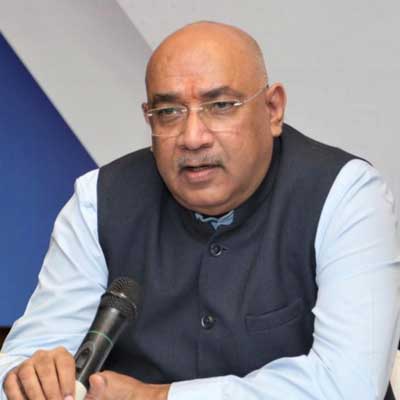What infrastructural progress in the roads segment have you witnessed over the years?
Most of the infrastructure development witnessed over the decades was funded out of the budgetary allocations and the government was solely responsible for making the infrastructure development possible. Since 1991, we have seen a shift in our state of fundamentals. In the new millennium, it was felt that for faster growth, adequate infrastructure facilities were needed. Be it road, port, airport, or power connectivity, all these are necessary for improving trade, commerce. and per capita income of masses. A multiplier effect is generated because of infrastructure development.
But to ensure the fast growth of infrastructure, and to reach the desired double-digit GDP growth, the budgetary allocations then were not enough. And therefore, the public-private partnership (PPP) model was started in procurement, and private investments were encouraged. It has been a great journey for infrastructure development in India. Although the initial few years were full of learning, and various modifications and new reforms were initiated, it is an ongoing process of improvement. The infrastructure sector as a systematic sector is still at its nascent stage, just like a budding teenager, and constant support of regulations and reforms is highly essential. Going forward, we have learned a lot in the development journey which is enabling us to scale up the curve.
The pace of growth of infrastructure is faster than ever before, as witnessed in the development of the roads. And the same success is witnessed in the power sector, alongside commitments to carbon reduction with a great potential for renewable energy to be realised. Airports, ports, urban sanitation, and some difficult terrain projects near the border areas are also getting a big boost.
The country is witnessing infrastructure development like never before and all this has been triggered by the aspirations of the people of India.
What is your take on the pace of road construction in India?
The road construction earlier was limited to minimalistic designs and development. However, now we are looking at larger connectivity with the Bharatmala Pariyojana program being a significant example. The road ministry has put in place a highly comprehensive framework for connecting all the major metros having radial connectivity with all the other nearby small towns. Apart from these, we have dedicated freight corridors to carry the cargo traffic from one corner to the other.
Road development plays a pivotal role in infrastructure connectivity and is highly essential for ensuring trade. For instance, the last-mile connectivity of carrying cargo goods from the manufacturer to the end user is highly beneficial. Probably a decade ago road development in India was just about 5-7 km per day, but today we are looking at developing 37-40 km per day. According to the road ministry, we now have garnered the confidence and are aspiring to achieve 60-70 km per day, and perhaps could go all the way up to 100 km per day in the future.
The kind of developments taking place in the road sector is tremendous and is providing a fillip for multiple sectors within the country to become more vibrant and stimulating to contribute to the overall GDP growth.
Can you throw light on the key government initiatives for financing the road sector?
The road sector is one of the oldest infrastructure sectors which had its own journey. The first concession for public-private investments came in 2002-03 and there were a lot of learning ever since. Infrastructure projects require high sunk costs. Initially, finances came majorly from the public sector commercial banks. IIFCL was set up in 2006 to ensure that the infrastructure projects do not suffer due to lack of finances. Commercial banks, which sourced about 85 per cent of their funds from retail sources, had an average tenure of about three to five years. They were not in a real position to fund infrastructure projects requiring long-term funds for around 15-20 years.
The huge mismatch of assets and liabilities was one of the major reasons which put the banking funds at market risk and to alleviate this IIFCL was formed. In the development of infrastructure projects in the road sector, the initial concessions had their own drawbacks. Those initial concessions did not have any renegotiation clauses, as the long-term funds for 15-20 years would generally witness multiple governments with several officials changing during this process. This can be termed as generation financing.
Considering these aspects, it was difficult to forecast the near imperfect economy of the past. And yet with all the precautions and safeguards to perceive risks, we did go ahead with the development of roads with a success ratio of 80-85 per cent of projects. While the remaining per cent ran through some or the other problems, few were resolved and few were unresolved due to inadequacy of faster approvals, unclear land acquisition laws, environmental approvals, and untimely inter-ministerial approvals. In case of certain unexpected problems, renegotiation clauses were found to be missing. The aboriginal sanctioned terms had to be carried out until the final execution. All these created a certain amount of delays.
All these issues were addressed in 2014 when Kelkar Committee was constituted, and a new lease of life was provided to the road sector. Ever since the reforms started happening at a faster pace, the bidding methodologies changed, the procurement models were revamped, and the hybrid annuity model (HAM) was introduced. Today, the road sector is more mature and robust, but we need to do much more. The resolve should be there and we need to look forward. Just the way Rome was not built in a day, infrastructure sectors also take a long time to stabilise. Today, the roads sector is fairly stable and with the kind of reforms put in place, it seems to be full of potential.
The concession agreements of today are bipartite in nature between the authorities and the concessionaire. The lenders, despite being the largest stakeholder in the financing of the project are not a party to the concessional agreements. We at IIFCL are advocating a tripartite nature of concession agreement so that lenders are able to pre-empt any unilateral action on behalf of the borrower.
We have come a long way since 2005-06 when private investments were ushered in the roads sector. We are comfortably ahead of the curve and looking at many initiatives like monetisation of roads, evaluating to make investments in roads self-sustaining, and introducing of InvIT models which is a new-age instrument. The future holds pretty great as we stand today.
Are there any gaps in infrastructure financing that can be filled to make development more efficient?
The NIP envisages INR 111 lakh crore in the next five years. The gap envisaged in the NIP is estimated approximately at INR 10 lakh crore. The rest of the amount is very much accounted for by all the financial institutions, including the private sector. Monetisation and new-age instruments like InvITs are expected to stimulate the kind of resources to fill the gap. For instance, today the outstanding loans of banks and the NBFCs put together stand at around INR 26 lakh crore with NBFCs being at about 63 per cent and banks at 37 per cent. If the INR 26 lakh crore has to be further analysed, it constitutes about 30-40 per cent of completed projects which amounts to about INR 11-12 lakh crore. This amount is already available for disbursement to bond markets for resale and to get the liquidity churned back.
Currently, we are witnessing a lot of appetite from global foreign funds like pension and superannuation funds, particularly in completed projects. They are investing in InvITs which in turn is buying out such projects. On one hand, it will partially release the equities for the developers to further take up projects from that churned equity. While on the other hand, if such projects are taken away from the banks, the banks will get the funds to regenerate more funds towards infrastructure projects. This architecture is now becoming possible, and the bond market is becoming more active than before. The latest bond issuance of NHAI InvITs garnered about 15,000 investors from the retail space. This is perhaps the first time that any infrastructure project had garnered retail investors.
According to the NHAI InvIT management, after a couple of months of the issuance, the investors’ participation turned out to be around 28,000. It means that the trading has started and liquidity is being generated. These are all signals that we have enough potential within the infrastructure sector.
Completed projects are the main assets that the investors are looking at for the past three years. We hope this will burgeon and expand widely and deeply, and the infrastructure assets or projects, after its completion, would be taken over by such investors. While the banks and financial institutions could fund for three to five years, the other investors and the bond market can fund the projects for the residual years over their lifetime. We are not just looking at the next 10-15 years, but for a much longer duration, as the bond market can churn the assets for a longer period.
Let’s consider the example of Euro Tunnel connecting London and France. It is a purely private sector financed project involving 203 banks with 99 years of concession being sanctioned. We aim to move in such a direction as far as infrastructure financing is concerned.
What is the future of InvITs in the infrastructure financing domain?
InvIT, a structure instituted by SEBI, is a sound mechanism to enable developers to release their already invested equity in the projects, and yet continue to manage the project for the benefit of the investors in the InvIT. India has always suffered from the number of developers. If we compare the kind of infrastructure required for development with the supply side, there has always been a deficit in the number of developers, and consequently, equity pressures came into existence. For the private sector investments to augur well with the existing government interventions, it needed more developers and equity from the private sector itself. InvITs are an apt instrument in such a scenario, as they can play a meaningful role to release the equities. The HAM model can also support well, as it plays a vital role to bridge the gap between an EPC model and a PPP model.
In areas lacking a good revenue collection, instead of an EPC model with 100 per cent government support, a HAM model can be diligently employed. Instead of pumping in 100 per cent capital for the infra projects, partial funding can be done by the government, and the balance funding can be taken up by the private sector. It will graduate the lower-level contractors into the developer’s stream. Over a while, these contractors can update their skills and experience and mature into the developer’s shoes.
On the financing side, InvITs provide a good opportunity to down sell the already constructed projects to be able to release its equity. It is an important aspect of development. The InvIT model takes up only the completed projects, moreover, it can also issue bonds. Overall, it can create a good secondary market that can improve the velocity of the flow of money.
What are the current priorities for IIFCL?
IIFCL will continue what we have been doing, which is to innovate and to ensure that we play a leading role as an innovative infrastructure finance lender. We have developed new financial products that have become mainstream products, be it subordinate debt, credit enhancements, or takeout finance. We are now investing largely in bonds for infrastructure projects and ensuring longer-term commitments from financial institutions to infrastructure projects.
We will continue to advocate the policies and play a meaningful role between the infrastructure sector and the government. We shall also try to get the dialogue effectively across. In the future, IIFCL could see itself emerging with larger responsibilities and larger areas to cover such as alternative investment funds, bringing investors, churning its assets, and enlarging its sanctions and disbursement base to cover a variety of sectors and projects.
How do you envision the future of infrastructure financing?
The long-term aspects are important in infrastructure financing and today with these new-age instruments it can be made possible to a great extent. This is a new architecture beginning to take shape. It is all about banks and financial institutions taking a limited exposure of three to five years or up to the completion of the project. And post completion, it can be taken over by a mix of investors, InvITs, and banks or financial institutions depending on their liability or lending capacity. The churning of finances will be there till the economic life of the project. This will enable the project to access longer-term loans, thereby providing better viability, DSCR, and overall financials. This has been possible so far in roads, transmission, and renewable sectors, while the other sectors have to catch up.
The future of infrastructure financing lies in the multiplicity of institutional support that enables long term financing. It also depends upon how well the projects can be structured to suit each of the viability profiles of the investment and the financing institutions. Structuring the projects will become a vital aspect of success in the future.


















